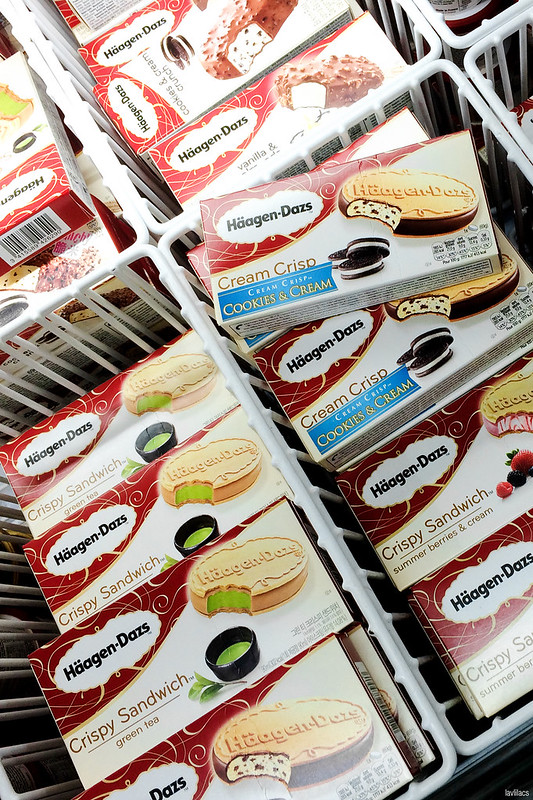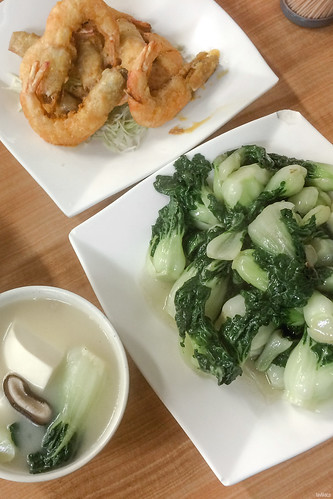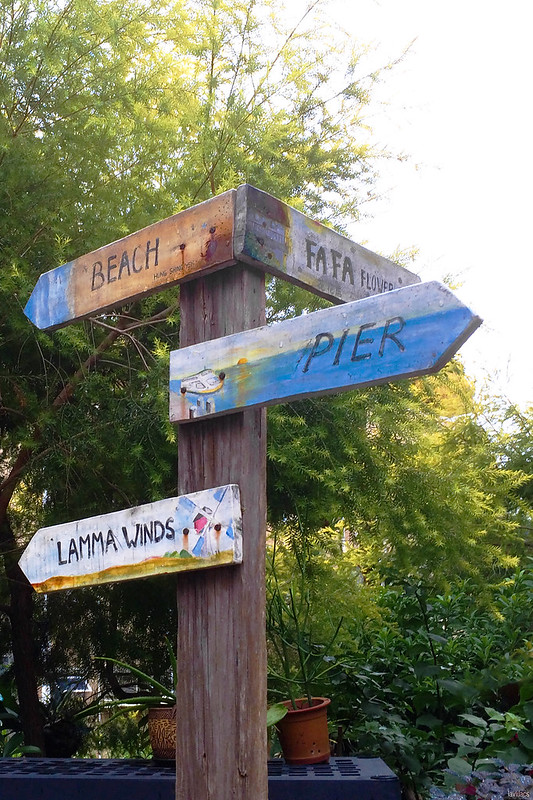There probably will never be a similar scenario to the one I had while staying in Hong Kong. In 2.5 months time, I was in the city on 9 separate occasions. A majority of those visits were travel days, in and out of HK International Airport or crossing the border going to and from Mainland China. The other times were all, more or less, extended layovers.

This style of visiting a city is only possible because HK is an international travel hub, an Asian-Pacific one to be more exact. If a circle was drawn over most of Asia, Hong Kong would practically be at the center. It makes it a great city, location-wise, to be a home base for anyone looking to visit the Eastern hemisphere. (Price-wise is a different story though.) A few hours on a plane in any direction will literally land anyone in another country.
1.5 hours = Taiwan.
2 hours = Philippines, Vietnam.
2.5 hours = Thailand.
3 hours = South Korea.
3.5 hours = Malaysia.
4 hours = Singapore, Japan, Mongolia.
4.5+ hours = India, Indonesia, etc.
At the time, I was traveling to multiple Asia countries consecutively via a popular HK based airline company. Hong Kong became my temporary home away from home. I spent the most amount of total days there out of all the places I visited. Sometimes the metropolis was a transient point, lasting from several hours to a day or two. Sometimes it was a more purposeful stay: visiting friends & family, attending a wedding, and good ol' exploring.
Since each visit in Hong Kong was for a slightly different reason with varying needs, the type of places I stayed in also varied. All hotel rooms & price ranges mentioned were for the basic/standard rooms sizes I paid at the time unless otherwise noted.
Family & Friends (free or a good meal/drink).
When the layovers were only hours long, my heaviest suitcases found a resting spot at a local Auntie's home. If not for her generosity, I would have either been 100% stressed with dragging two suitcases around crowded Hong Kong or 100% acquainted with every nook and cranny of the airport.

Budget (under USD $100/night)
When my mom and I were en route to Taishan with bags of clean clothes, we chose to focus on affordability. Budget hotels can mean a lot of different things; it is all relative. In Hong Kong, "budget" is generally:
- anything under USD $100
- where space is very very limited
- in slightly more residential areas
- either kind of outdated, old-ish, or super new.
Dorsett Mongkok seemed to fit our checklist at the time. It wasn't too expensive. MTR seemed to be within walking distance. The hotel looked pretty well kept and modern in the photos. The dealbreaker was the promise of a complimentary working smartphone with local/international calling and data capabilities.
We ended up staying 2 nights in the Tai Kok Tsui neighborhood. This was our first time staying in HK so we didn't know what to expect in terms of room capacity and getting around. Numbers can only mean so much on a screen.
When I said that "space is very very limited", I mean it and with both very's. There was just enough space for the bare essentials and maybe 2 carry-on sized bags at most. The two beds are twin sized. If the cabinet doors are open, the only way to get from one end to the room to the other is by scaling the beds. The bathroom area was quite literally a nook in a box and had precisely enough space to stand and turn around in but not much to stretch out any limbs too far.
It was great to have 3 stations within 15 minutes walking distance from Dorsett. It just took a few tries to get used to the non-uniform streets in the area. Finding the entrances to overpasses to cross a big road was something we had to adjust to. Name-only streets where roads weren't perpendicular was also a challenge for us first-time visitors. I think a lot of it also had to do with the fact that we were more accustomed to a numerical grid street system.
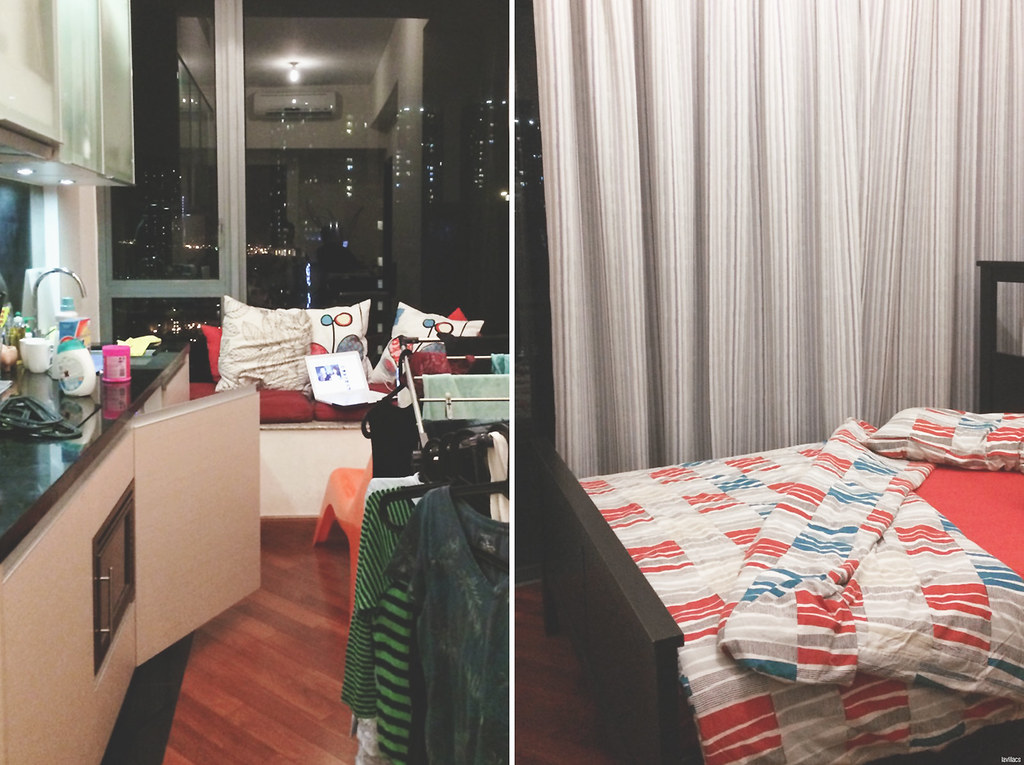
AirBnB (wide variety)
When we were en route to Taishan with bags of dirty clothes, a budget apartment with a washer and dryer was our home for a couple of nights.
Coincidentally, I booked a 1 room apartment in a new luxury building in Tai Kok Tsui a stone throw's away from the Dorsett Mongkok we first stayed at. It was the cheapest option (~USD $120) on the Kowloon side that listed having a washer & dryer combo machine. We were also ready to graduate to a slightly roomier accommodation after staying in the bare-minimum the previous visit.
While the apartment wasn't large by any means, it had enough square footage available so that neither of my mom nor I felt pressed against each other. The kitchen, dining, and seating area were separated from the sleeping area.
For me, the most exciting part of our AirBnB stay was getting to experience apartment life. The home had actual metal keys. We were instructed on where to throw the trash and recyclables. We could have even cooked food on an electric range if we wanted to. It gave me a small taste of what living in Hong Kong could be like and I found that the most satisfying.
*Any place that has a machine that does both Wash & Dry, beware! Wash it does, dry it does not. At best, the machine spins most of the moisture out and gets clothing a little steamy. Air drying is the norm in Hong Kong and the machine's "dry" cycle doesn't really shorten the drying time.

Apartment Hotel/Suites (~USD $150/night and above)
When we were in HK for a few days before the mom and I had to part ways, a bigger hotel room suite was necessary. Even with the extra space of the affordable AirBnB, it would not have been enough space for the 6+ suitcases the both of us had.
Ovolo West Kowloon in Sham Shui Po was perfect for our 3 nights: not overly expensive, super-duper spacious, and their complimentary laundry room had working separate washer and dryer machines. I believe each hotel room had a living room area and kitchen area (sans stove). Some rooms had separate bedrooms while others were more studio like. The couch was big enough to sleep another person. The fridge had complimentary drinks. There was a big HDTV with Apple TV. Overally, the hotel had a homey feel with all the benefits of a hotel.
It is such a shame that Ovolo seemed to have closed this location down recently. This was definitely my favorite of the three places I had stayed in, at the time. I couldn't find any information on why it closed. I could have seen myself choosing it in the future if I were to stay in Hong Kong for longer than a couple of days or with a few other people.

Photo source: Google
Mid-Range (~USD $100-120/night)
When my aunt and I were in HK, accommodations in the heart of Kowloon was way more desirable. I had spent enough time in lodgings that were in quieter areas of the city. For the last few nights in Hong Kong, I was glad my Aunt suggested we pick a place steps away from the busiest neighborhood in the city.
Stanford Hotel in Mong Kok was our abode for 5 nights. I think we may have had a room upgrade during our stay because my record shows we paid for a "Standard Room" but my memory of our stay looked more like their biggest room option that is available now (i.e. Skyline, photoed above).
I cannot attest to all rooms and hotels when comparing budget and mid-range hotels, but the one we stayed in at the Stanford was more spacious than the one at Dorsett Mongkok. Roominess aside, even the location alone was worth the extra ~USD $20/night.
There were so many food stalls and sit-down restaurants to choose from. Main commercial streets are lined to the brim with big name clothing, cosmetics, and electronics shops. Side streets are filled with different markets specializing in all kinds of goods: toys, sneakers, goldish, kitchenware, souvenirs, etc. If you can name it, there is probably a market or at the very least a vendor at a market that sells it. On weekends, the busy Sai Yeung Choi Street becomes a no-vehicle zone where people meet in hoards to perform, sing, and hang out.
I could wander around the streets until midnight and still be able to comfortably walk back to the hotel by myself. It was the perfect place to be during the last few nights in HK, a food lover's heaven and a shopaholic's dream.

Despite the numerous stays in Hong Kong, I would go back. I had 12 sleeps there but only 5 full days of exploring. Go figure! A lot of the older generation in my family would prefer not to stop in HK, but for a young adult, like myself, it is a city of many appeals. Who knows maybe next time I'll stay on the other side of the harbour for a change?
Hong Kong is a place where visiting as a Cantonese speaking ABC (American Born Chinese) is an experience like no other. The biggest appeal of the city comes from the balance of familiarity and novelty. My family has a Taishanese history, yet we are still a part of the larger Cantonese culture. People who only know Cantonese may not be able to make out the Taishanese dialect, but those who understand Taishanese can definitely find the similarities between the two. Food-wise, the cuisine and choices available are practically identical. Dimsum and yumcha are social gathering musts. Sweet tofu pudding and sweet soups are desserts of choice. The distinctions, instead, come from cultural differences due to environmental influences: traditionalist v. fusion, relaxed v. rushed, roomy v. rushed, smoking v. no smoking. etc.
The internet loads my brain with hundreds of images of foods to try without knowing precisely where to get it or what it is called. Navigating the streets in search of eateries is effortless as signs are in English and Chinese. Speaking Cantonese is sort of easy-peasy. Understanding and deciphering the local slang though makes my language skills seem even more elementary. Even though a big city's hustle doesn't faze me, there is a sense of order despite the rush in Hong Kong that is initially shocking. It shows in the way people line up queue up for restaurants and in the way certain food names are shortened to the least amount of characters that is still humanly understandable in order to keep lines moving. It is weird to feel like I can know so much and so little simultaneously.

Australia Milk Company, Jordan, Hong Kong.
Perhaps the best example of Hong Kong culture rests in a simple breakfast meal. Not at a restaurant where little steamers of dimsum are ordered, but at a "tea restaurant" or cha chaan teng 茶餐廳 where space is limited, tables are cramped, and people are a plenty. Lines at popular establishments can wrap around the block. Workers can be somewhat rude and seemingly annoyed at all times. But their thick skin is probably what gets the queues of visitors moving at a reasonable rate.
Macaroni and ham soup. Ham and egg sandwich. Pineapple bun. "Stocking" milk tea. Coffee tea mix. Lemon with honey. Those are the representative cha chaan teng menu items. None of it sounds super fancy, it is what it is. Individual items are affordable and set meals are even better deals. Everything can be prepared quickly and eaten hastily. That's what makes tea restaurants tick.
Don't let the name Australia Milk Company fool anyone. It might sound like a foreign chain but it has all the hallmarks of a cha chaan teng and then two- three-folds. The lines for indoor seating is neverending, but for a good reason. Luckily they have a shorter line for To-Go visitors that is attended by someone just as brash as those attending to table service.
As an establishment with milk in its name, their milk puddings are definitely a treat. It is rich and creamy and available both hot and cold. The star of the place though is, without a doubt, the scrambled egg sandwich. Their bread is thick and pillowy soft. The eggs are fluffy and buttery. Gaahh, the combination is just to die for! I know, I know...it is just egg and bread. Every cha chaan teng offers it. I thought that too until I had it from other places. Australia Milk Company really is much better.
*TIP: For Cantonese speakers, don't bother with saying the full names of any of the menu items. For tui daan sam mun tsee 火腿蛋三文治 (ham and egg sandwich) it is not; tui daan tsee 腿蛋治 is much more appreciated. For English speakers, ask for an English menu and point or try saying ham egg sandwich toast.

Let me stop a moment to gush about getting milk in a glass bottle. This completely caught me by surprise. It is not common to buy single portion milk. It is even less common to find it in a glass bottle unless it is organic, raw, unpasteurized, or anything of that nature. Then on top of all that, the bottle should be rinsed and returned instead of to be trashed? Shocking!

HK Brands & Products Expo, Wanchai, Hong Kong.
Growing up, tofu pudding (dou fu faa 豆腐花 or dou faa 豆花) was always a treat at dimsum or if my mom happens to stop by the tofu vendor in Chinatown. It always seemed like an adult's dessert because of its lack of color, decorations, and texture. When I spotted a bunch of people carrying around bowls of the tofu pudding with colorful cubes I was immediately intrigued. I couldn't read the name at the time but just assumed it was taro ball 芋圓 and sweet potato balls 地瓜圓 from its appearances. Those weren't like anything other rice balls I have ever had. Instead of a soft mushy texture and round shape, it was springy chewy and cubed.
The taro and sweet potato balls supposedly originate from Taiwan and are made with sweet potato starch rather than glutinous rice flour. I guess that explains why I haven't ever had anything like it before. Since I saw these at the HK Brands & Products expo, I wonder if they are popular in dessert shops in Hong Kong?

Chung Kee Dessert, Jordan, Hong Kong.
Glutinous rice balls in syrup is another representative dessert of Cantonese cuisine. Homemade versions are typically on the plainer side, i.e. filling-less, and Grandma and mom are usually more generous when scooping the dough balls.
Dessert shops usually incorporate special flavors into theirs since the plain ones are really easy to make. (Some glutinous rice flour + water forms the dough. Some sugar + water makes a syrup.) Putting filling inside the dough while ensuring it is fully encased and evenly wrapped is tedious and meticulous work for unskilled hands. How else would dessert shops make money?
Anyways, my favorites versions are the red bean and mango varieties. It is just personal preferences. Red bean and black sesame are more traditional options. Green tea and mango are more modern influences.
Kwan Kee Store, Sham Shui Po, Hong Kong.
I wasn't actively looking for these sweets while in HK. I would have been happy if I stumbled across it and not overly sad if I didn't. I think more than wanting to try it per say, I wanted to experience buying it from a street hawker and eating it skewered on two bamboo sticks like in the TVB shows.
While these are sweets, these are usually classified more as snacks than as after-meal desserts. Pudding cake (put chai ko 砵仔糕) and white sugar cake (bak tong gou 白糖糕) are both rice flour and sugar based steamed desserts. Both can come in white or brown sugar versions. The main difference between the two is the white sugar cake has a leavening agent and is fermented while the pudding cake is not.
Put chai ko is kind of like a non-chewy version of ddeok/tteok (Korean rice cakes). It is soft when fresh but still has a firmness to it.
Bak tong gou is springy and slightly chewy. Depending on how it is made it could range from light to kind of dense. Since it is fermented, there is a tinge of sourness.
The ones I tried from Kwan Kee Store were different from what I imagined it to be. Maybe I have just developed a specific taste for both of these since I had them often growing up. The put chai ko was just a tad too firm and the bak tong gou wasn't springy, sour enough to my liking.

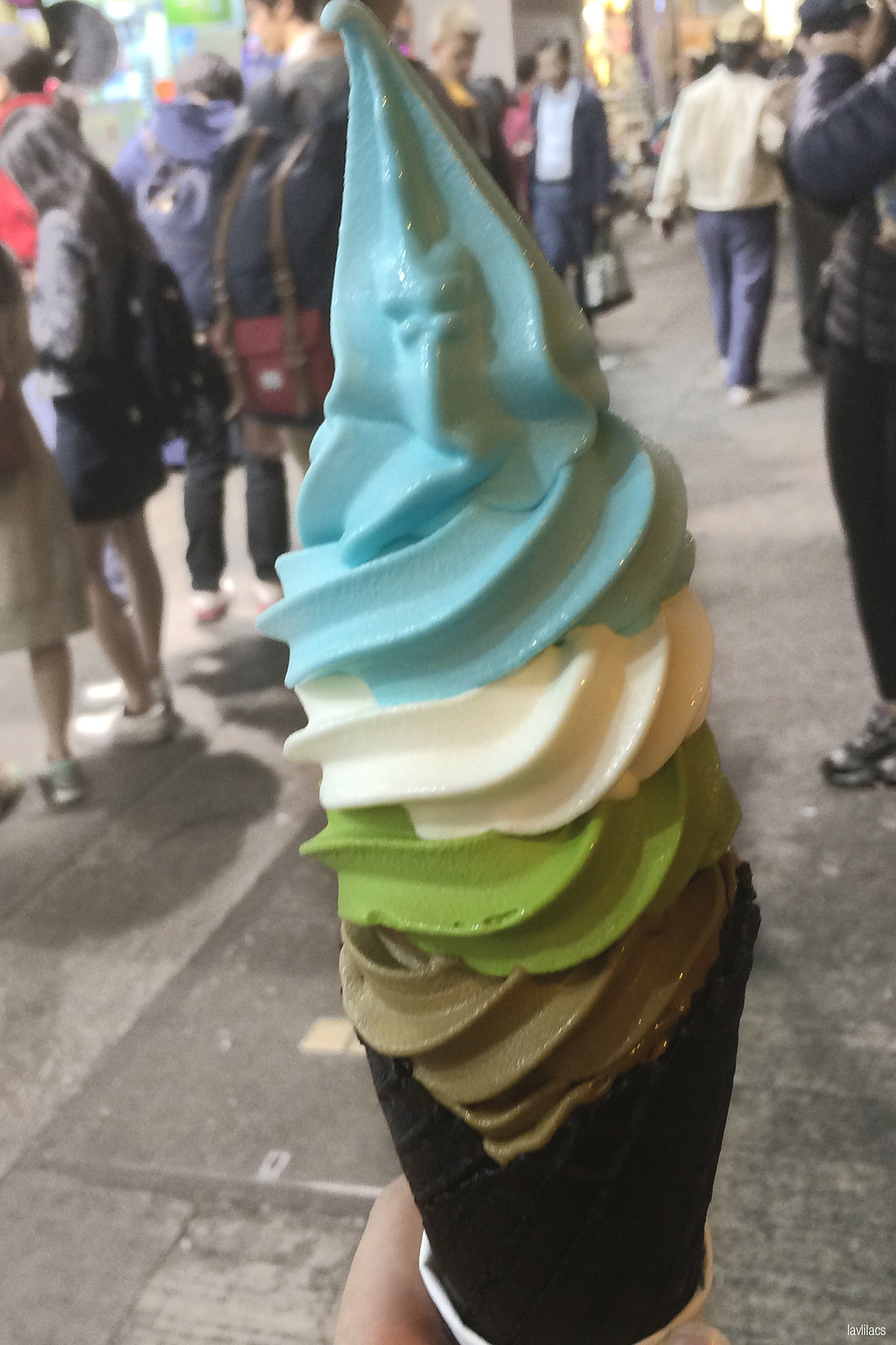
Mong Kok, Hong Kong.
Oh, the street food haven that is Mong Kok! Every corner turned will have another eats screaming to be bought and devoured. I am glad that I was able to stay in a hotel that was steps away. Let's just say it was thanks to being able to do some snacks hoarding from the Mong Kok stalls that helped me pull an all-nighter in an attempt to adjust to jetlag.
The variety of street eats available in MK is overwhelming. Savory v. sweet. Fried v. stewed. Local v. international. Cold v. hot. Visiting Mong Kok on a full stomach is most definitely a terrible idea. Even if shopping is the top priority, food smells will surely find its way and the cravings will be hard to ignore. Tons of stalls and shops sell Cantonese classics, but new Instagrammable and trendy spots are just as popular amongst the locals.
Some "Must Try" items are definitely curry fish balls with tripe stew, foods on a stick, and waffles of any kind (egg/bubble waffle and normal one sandwiching jam).
Fa Yuen Street Cooked Food Centre, Mong Kok, Hong Kong.
Although this isn't an authentic outdoors, open-air food stall (daipaidong 大排档), Fa Yuen Street Cooked Food Centre is similar enough in an indoors setting. The Cooked Food Centre is located in a multi-floor complex that also serves as a wet market. The lower floors, I believe, sell veggies, fruits, poultry, and even roasted meats.
Those looking for a sit-down meal can find it on the 4th floor. Some stalls sell congee and breakfast staples, others specialize in stir-fried offerings. The food is straightforward and cheap. Tables are foldable and chairs are stackable. No frills but still tasty, homecooked-esque. Nothing really is quite like this Stateside. The closest thing I can compare the food centre to are the Singaporean hawker centres.

Curry House CoCo Ichibanya, Mong Kok, Hong Kong.
CoCo Curry and I seemed to be ill-fated. I first saw it in person in Seoul. By the time I wanted to give it a try there (maybe within the week of discovering it) the place complete shutdown and was being renovated into something else. I forgot about CoCo Curry in Tokyo where there were so many other foods to try. Maybe I would have remembered it if I saw one during my time there but I somehow never noticed. It took three separate stays in Hong Kong to finally be able to try their famously delicious curry, katsu, and egg combo.
The one at Langham Place didn't offer the customization options that the chain is known for. But that didn't matter to me as a first-timer. I was there for one thing and that was saucy rice with fried meat. Having tried CoCo Curry now, I get what the hype is. It is hard to pinpoint exactly it is about it. Their curry is definitely great and I love how it is just a sauce without any carrots or potatoes. I don't remember it being too spicy but I would like try the spicier levels if I come across another CoCo.

Empire City Roasted Duck, Tsim Sha Tsui, Hong Kong.
A food adventure isn't complete without a meal that is stumbled upon by chance. My Aunt and I passed by this duck themed restaurant during one of the last few days in HK. It was right near the one shop I really wanted to visit and the both of us love to eat duck, so why the heck not?
Can you tell I liked being able to assemble my food? The roasted duck slices were meant to be wrapped in crepes and veggies. The stir fried minced duck meat was meant to be scooped into the hollow bao buns. We ordered a lot of food for just a party of 2, yet I remember we devoured almost all of it.
I definitely expected more roasted duck for the price (the above photo is 1/2 a duck for ~HKD$250 more or less). But considering the number of other dishes we ended up ordering to try, I was glad the portion sizes of everything were on the smaller side. It would have been a hassle to pack leftovers since our hotel room didn't have a microwave.
Of all the things that someone typically hears about from people who visit Hong Kong, Lamma Island 南丫島 is a name that probably doesn't come up frequently. It is a place that can only be reached by ferry. It is an area where cars, vehicles, and metros do not run. It is a spot where bicycles and human leg strength are the only modes of transport on the island.
Everything about Lamma Island screams quiet, tranquil, and relaxed: small population, surrounded by nature and water, and not heavily commercialized. The seemingly perfect getaway from the hustle and bustle of the international metropolis that is Hong Kong.

The ferry ride from Central to the island's most northern pier is short and inexpensive. Yung Shue Wan is the alighting point most prefer; most of the islands' residents and shops are located here. Sok Kwu Wan is another disembarking option that is located a little further south on the island.
Rows of fresh seafood restaurants greet visitors at both docks. Eating a rustic local seafood meal by the water would seem like an obvious choice. Peeling shrimp and picking at clam meat while hearing the tide swish in and out, how picturesque. (Prices could be expensive since it is a "tourist-y" activity.)



For the non-seafood lovers, the island is home to many expats who run restaurants and shops near Yung Shue Wan. For the frugal travelers, buy some to-go eats at a local cha chaan teng 茶餐廳 or from nearby bakeries before boarding the ferry over. There are plenty of public spaces on Lamma Island to have a picnic of sorts.
I hadn't a clue what to expect prior to visiting the island. The only times I have heard Lamma Island was in the few instances it came up in TVB shows I watched as a kid. Who knew it is supposedly a popular spot for expats to move to? Who knew a lot of the houses and villages there are pretty run-down and/or abandoned? Who knew, despite that, the island is still a little hipster-y and artsy?

The hiking trail is the one thing I discovered about Lamma Island and gladly accepted with open arms. Since I travel to eat, any extra "strenuous" activity is always much needed and very appreciated. The path is well paved and marked from one major pier to the other. It is estimated to be a 1 hour and 20-minute walk, via the orange course on the map above.
The marked paths on the map do not reach the tallest point on the island. But they aren't exactly brisk walks through the park either; there are plenty of steep uphills along the way. Even though I would recommend a good pair of walking shoes, it isn't a must. Heck, when I went I saw a trio of ladies in dresses and chunky heels hiking along the same path and sometimes at a faster pace than I could do.
To some, the visit could be uneventful. Scruffy dogs wander about. Run-down looking homes sprinkled throughout. Views of water, fog, and the power plant are more typical. Air-conditioned mega malls are definitely not aplenty. But this little island has its charm. I wouldn't spend a full day here if I were to visit again. Half a day is just enough to explore and still be able to fully appreciate everything.




















